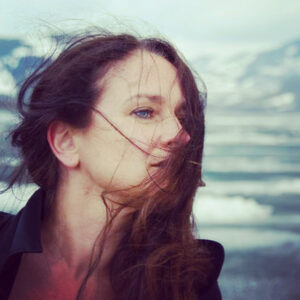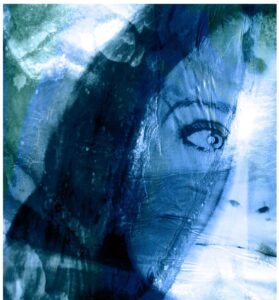The Voice in the Mountain
— a study of the human voice's resonance in interaction with the South Greenlandic mountain
 By Associate Professor Bebiane Bøje
By Associate Professor Bebiane Bøje
Background:
The idea for this project began with a desire to explore the sound, shape, texture and color of the mountain/‘fjeld‘ behind the house where I grew up in smalltown Qaqortoq, Greenland. The unique sound of the different vocal colors in the human voice, reflecting the colors, shape and textures of the hard and unforgiving ‘fjeld’.
I come from a background with a very specialized knowledge of the human voice, and an extended experience as a singer. For this project I decided to explore the changing resonance of the human larynx and pharynx, and to conduct a study on human vocal sound, projected on the black and bare mountain.
My research question was: Is it possible to capture the color, shape and texture of the ‘fjeld’, and transform the visual and tactile impulses from the ‘fjeld’, into the sound of the human voice?
Methods:
Voice experiments leading the way
First field-study
During an artist residency in the Qaqortoq area, I succeeded in conducting a series of voice experiments, in exploring the concept of the human voice in the ‘fjeld’. The experiment was recorded (primitively) as my first investigative attempt to capture the essence and build the foundation of this project.
Processing the collected data
The first field study led to a collaboration with pianist/producer Jakob Gunnertoft. Over the next months, we chose the best of my field-recordings and co-created a clear and ‘fjeld-like’ universe. The field recordings became the core sound of the three musical pieces of the project, which were recorded professionally and brought to life in Finland Studio, Aarhus, with a selected group of professional musicians. In the process of creating the musical expression of my experiments of the first field-study, we decided to record and publish a full album of songs. Out of those songs I chose to use three of the songs for the elaboration of this experiment: One original song, and two songs by Danish composer Carl Nielsen.
Cross-aesthetic collaboration
To investigate the cross-aesthetic possibilities and to explore the visual content of the project we initiated a collaboration with Norwegian artist Svein Rosseland. Svein Rosseland is a Norwegian (internationally awarded) artist, working with camera based fine art, short film, sound, performance and poetry.
Through phone conversations and e-mail correspondence we elaborated on the subject of ‘the voice in the mountain’. We discussed the shape, texture, sound and color as well as other characteristics, such as the darkness and hardness of the ‘fjeld’. The conversations turned into a desire to dig even deeper into the experiment of the project.
Second field study
During this part of the project I conducted my second field study on the ‘fjeld’ with the intention of immersing myself further in the investigation of ‘the voice in the mountain’. This time not on my own, but accompanied by Svein Rosseland.
In this second field study we discovered, or more precisely, ‘felt’ a fine poetic voice emerging. The human voice in the ‘fjeld’ became a connected artistic expression, organically changing as color, shape and texture changed. The poetry of the experiment evolved as we explored the encounter between human voice and ‘fjeld’. The further we walked into the ‘fjeld’, the sound, shape, texture and color also seemed to change into something dark and spiritual. The depths of the human voice and mind certainly appeared more present and our surroundings became overwhelmingly real. No longer an academic piece of work, but a true artistic and dangerous project.
The artwork
Now it is time to present the artwork that became the outcome of the experiments of our second field study, and the collaboration with Svein Rosseland.
The two pieces represent different techniques of visual art. My description will cover the aesthetics and not the techniques used in the process:
1. The art photo represents an almost gentle expression and is closely inspired by the first piece of music, Skumring. The wind is a key element of this art piece, as the organic and round features create a contrast to the pointiness of the face. The roundness of the breeze almost absorbs the cold temperature, the ice and the rock.

2. The darker poster art represents texture in an almost tangible and heavy way, which makes it possible to decipher different layers of rock and ice. With a glasslike transparency, the surface invites and challenges you to dive into the layers. Give yourself a minute to encounter and enjoy how the different corners of the material creates a curious and colorful maze on the mood of the surface. The motive is not the female face, but the developing of contrasts in the layers, from skin surface to deeper tissue. This piece of art reflects the second and the third piece of music: Sænk kun dit hoved and Tit er jeg glad.

The sound:
The music explores and mixes the elements and emotions from the ‘fjeld’, and develops into a more and more unforgiving and uncompromising energy. The music lies between silence and raw energy.
Part 1: Skumring
The first musical composition in the project is an elaboration over human transition. With the title ‘Skumring’, it gently predicts a change is coming. From daylight into a more dark and shadow-like type of light. The lyrics point in the direction of someone moving from the comfortable and well-known surroundings into new and dangerous territory. The fear is not yet devastating, but something new and disturbing might occur soon. The sound of the voice is calm, and primarily in the mode of curbing. With a relaxed articulation, and the controlled use of variating onsets, from the airy to much more compressed.
Now listen to the music:
Part 2: Sænk kun dit hoved
With a disturbing circus-vibe, the piece draws attention to the vocal choices. Observe how the choice of resonance varies from an almost spoken overdrive mode, to the delicate and controlled thinning of the vocalis muscles. Moving elegantly from overdrive, through curbing to neutral with air and a small vibrato. It is clear that these deliberate choices support the dystopic, playful but also dangerous vibe. The person is floundering in the dark. The use of extended vocal techniques with the creaks and cracking of the onsets is also drawing the attention to the fact that the ‘fjeld’ might have a hostile intention. The darkness and disturbing color, shape and texture of the fjeld is taking over the person’s self control before he knows it. There is also a dance around the parameter: pitch.The pitch varies from being correct to more lazy and imprecise. The voice also explores an atypical accentuation of the lyrics.
Now listen to the music:
Part 3: Tit er jeg glad
The knife in the darkness. In this third part of the experiment the cold and knife-like sounding fjeld is now taking over this person’s world. With a composition and production created by Wayne Siegel over a Carl Nielsen melody, the vibe is closer to the merciless cycle of life and death. The person might walk directly into the white-out of the ‘fjeld’ when his time is near. With the contradictory feeling between the lyrics and melody versus the metallic sound of the composition, this piece is more chaotic, dark and unreconciled. The voice has an almost fragile and crumbling essence. To create this mood more specifically is used a method of half open velum to invite a little more resonance from the nasal cavity into the sound. The level of the nasality is used in a controlled and variating manner. Another characteristic feature of the piece is the thin and almost stiff vocal chord work. It is never completely stiff as the headvoice is carrying the vocal mode, but there is definitely a hint in the direction of a flageolet.
Now listen to the music:
Collaborating artists:
Jakob Gunnertoft
Søren Poulsen
Wayne Siegel
Uffe Steen
Jacob Worm
Jakob Vendt
Morten Ramsbøl
Peter Sandegaard
Svein Rosseland
